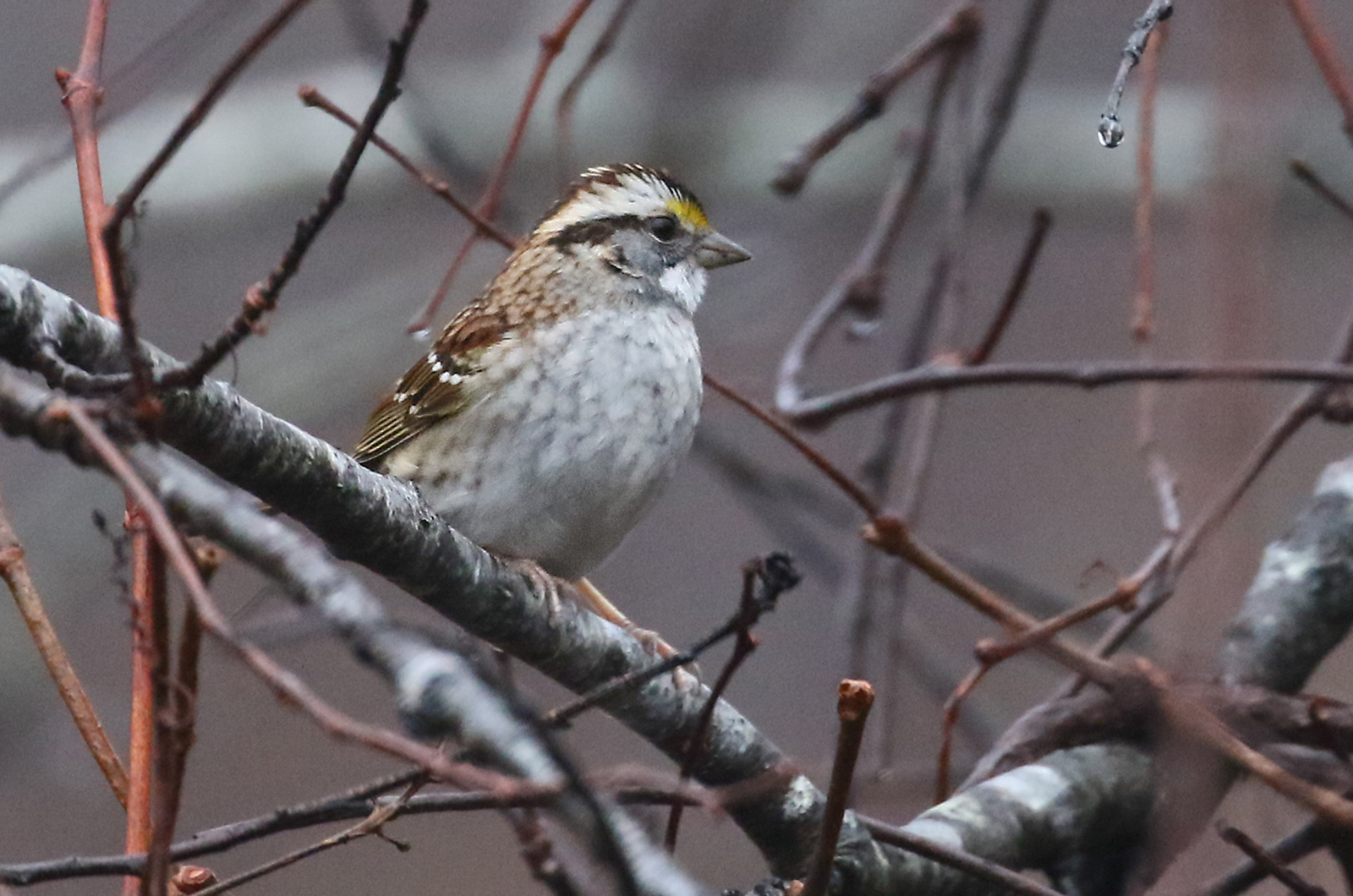Just about everyone knows a Canada goose by sight. Or so we think. Until recently, all sizes of Canadas were considered to be one species, even though they range in size from 25 to 43 inches in length and from 50 to 300 ounces. No longer. The four smallest subspecies were split off from the main Canada goose species, making the cackling goose.
One of the four subspecies — called Richardson’s Goose — has a population that spends their winters along the mid-Atlantic coast. Why is this important? Margaret Curtin reports seeing a small cackling goose “with a short stubby bill, short straight neck, and with a white wedge-shaped chinstrap,” near three much larger Canadas in Lagoon Pond at the bottom of Skiff Avenue on March 30.
Bird Sightings
Another unexpected sighting is the yellow-breasted chat reported by Scott McDowell on March 29. It is unexpected for two reasons: spring sightings are much less common than late fall-early winter sightings, and this bird was on the ground in a Menemsha yard instead of the more typical hiding within a dense shrub thicket.
More than 50 years ago purple finches were fairly common year-round residents, but now they are seen only sporadically, mostly in their fall southward migration. What flies south in the fall must fly back north in the spring, and an adult male was observed and photographed by Cynthia Bloomquist at her West Tisbury feeders on March 26.
Most spectacularly, Nancy Weaver watched an adult bald eagle carrying nesting material in Aquinnah on March 24, and the next day the trio of Lanny McDowell, Nancy Weaver and Bob Shriber spotted and photographed one carrying nesting material in Aquinnah. Carrying nesting material confirms that they are trying to nest somewhere on the Island.
Competition for nest boxes is interesting to watch. Mike Zoll reports that eastern bluebirds and tree swallows were competing for nest boxes at the State Forest headquarters on March 31, which is the first such report — and not to be the last — of the season. Thaw Malin and Cynthia Bloomquist also report finding three tree swallows in their yard on March 30.
The rest of this week’s news is about species departing for points north. Most notable is Matt Born’s sighting of 35 horned grebes in Vineyard Sound just outside of Woods Hole on March 27, and then a flock of 20 off Lobsterville Road on March 28. That is a lot of migrating horned grebes.
Bob Shriber saw a few seabirds as well: one horned grebe and 14 Great cormorants in Aquinnah on March 28, four northern gannets in Aquinnah the next day, and four horned grebes, 44 razorbills, three gannets and 16 great cormorants on March 31, all in Aquinnah.
Bob Shriber also had a bonanza of ocean-loving scoters. His numbers are less than they were in winter but most sightings at this time of year are of fewer individuals. He spotted 10 common eider, four harlequin ducks, 200 surf scoters, five white-winged scoters, 150 black scoters, 65 long-tailed ducks, 13 bufflehead and 12 red-breasted mergansers on March 31. Other species of ducks include Kari Sasportas’ finding five wood ducks, eight green-winged teal and 12 ring-necked ducks at the Wakeman Center ponds on March 24. Along the West Basin Road in Aquinnah Nancy Weaver spotted two mallard, seven black ducks, 50 greater scaup, one lesser scaup, 20 common eider, three surf scoters, 40 bufflehead, one common goldeneye and 15 red-breasted mergansers, plus a bonus sighting of the lingering western willet.
While at Squibnocket Beach, she found 26 lesser scaup, three surf scoters, one long-tailed duck, 25 bufflehead, one red-breasted merganser and, as a bonus, one Virginia rail, all on March 24. The next day on the Wakeman Center ponds she spotted four wood ducks, one black duck, four green-winged teal and 20 ring-necked ducks.
At the Oak Bluffs pumping station Margaret Curtin found three mallard, seven bufflehead and two red-breasted mergansers on March 27. To cap off her week, Nancy Weaver spotted the pair of over-wintering northern shovelers that had not been seen for more than a week, four American wigeon, six mallard, 20 bufflehead and one red-breasted merganser at Mud Creek on March 30. And Nancy Nordin spotted nine wood ducks at the Wakeman Center on March 31.
On a rainy March 28 Matt Pelikan birded around the BiodiversityWorks office and found a calling yellow-bellied sapsucker, white-throated sparrow, a brown creeper, about a dozen yellow-rumped warblers and a few golden-crowned kinglets foraging in the treetops. Yellow-rumped warblers are more abundant now than they have been. They have also been spotted by Ned Casey, who has eight of them visiting his Edgartown feeders. Nancy Weaver found one along West Basin Road on March 24, Lisa Maxfield saw four at Brush Pond on March 25, Ned Casey has eight visiting his Edgartown feeders, and on March 31 Nancy Nordin saw 16 at the Wakeman Center. Shea fee found two at Sepiessa Point, and Margaret Curtin found five at 183 State Road in Chilmark.
Not all white-throated sparrows have migrated north yet. Lisa Maxfield has one visiting her Brush Pond feeders, while Wendy Culbert and I still have two — one adult and one immature — visiting our feeders. Margaret Curtin and Nancy Weaver found two at the Oak Bluffs pumping station on March 27.
Similarly, dark-eyed juncos are pretty scarce. Keri Sasportas found six at the Wakeman Center on Mach 24, and most recently I spotted one briefly at my feeders on March 24, while Luanne Johnson has seen five near the Youth Hostel throughout March.
Please email your sightings to birds@vineyardgazette.com.
Robert Culbert is an ecological consultant with Nature Watch Living in Vineyard Haven.







Comments
Comment policy »